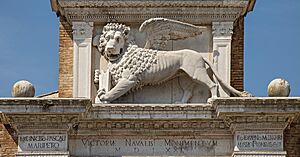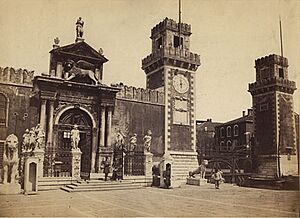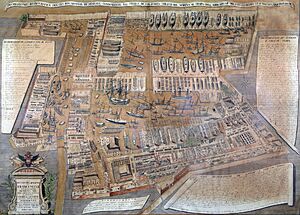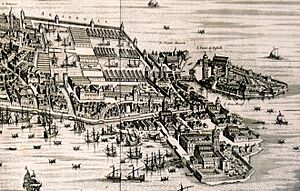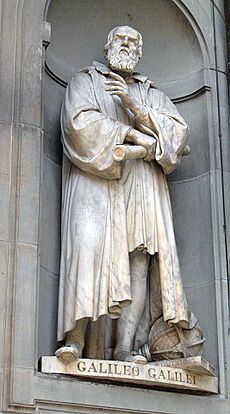Venetian Arsenal facts for kids
Quick facts for kids Venetian Arsenal |
|
|---|---|
| Arsenal | |
 The main gate at the Venetian Arsenal |
|
| Opening date: | 1104 |
| Owner: | Italian Republic |
| Location: | Venice, Italy |
The Venetian Arsenal (Italian: Arsenale di Venezia) was a huge complex of shipyards and armories (places where weapons are made and stored) in Venice, northern Italy. It was owned by the state and was super important for the Venetian Republic's navy. From the late Middle Ages to the early modern period, it built most of Venice's powerful ships. It was even called "one of the earliest large-scale industrial enterprises in history" because of how much it produced!
Template:TOC limit=3
Contents
What Was the Venetian Arsenal?
Building the Arsenal started around 1104, when Venice was a republic. It grew to be the biggest industrial place in Europe before the Industrial Revolution (when machines started doing a lot of work). It covered about 45 hectares, which is like 15% of Venice!
The Arsenal was surrounded by a 2-mile wall to keep it safe and secret. Workers and shipbuilders worked inside, creating ships that sailed from Venice's port. Different areas of the Arsenal made specific parts for ships, like ropes, weapons, and other gear. These parts could then be put together to build a whole ship in as little as one day! The wood for the ships came from a special forest owned by the Arsenal navy.
The Arsenal built most of Venice's trading ships. These ships helped Venice become very rich and powerful. The Arsenal kept working until Napoleon took over Venice in 1797. Today, it's still in the Castello area of Venice and is owned by the Italian state.
A Look at Its History
Some people think a similar place might have existed as early as the 700s. But the Arsenal we know today is usually said to have started in 1104. We don't have exact proof for that date, but it was definitely around by the early 1200s.
At first, the state shipyard just fixed private navy ships. But in 1320, the Arsenale Nuovo (New Arsenal) was built. This new part was much bigger than the first one. It meant that all of Venice's navy ships and even larger merchant ships could be built and fixed in one place. The Arsenal also became a big center for making ropes. Many workers who built ships lived in houses just outside its walls.
Mass Production of Ships
Venice found ways to build warships super fast at the Arsenal. They used a new method called "frame-first" building. This was different from the older "hull-first" way. The new method was much quicker and used less wood.
At its busiest in the early 1500s, the Arsenal had about 16,000 workers. They could build almost one ship every day! They could also get a newly built galley (a type of ship) ready with all its parts, weapons, and supplies. This was like an assembly line long before the Industrial Revolution!
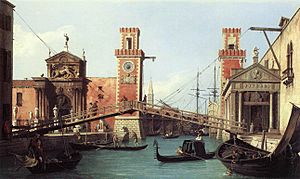
The Arsenal workers were very skilled. They also created new firearms early on. They made powerful cannons called bombards in the 1370s. A few years later, they made smaller guns to fight against the people from Genoa. These new guns could shoot faster than a crossbow and even pierce armor. The weapons made at the Arsenal were also useful for many things. A Venetian military leader named Bartolomeo Colleoni was one of the first to put the Arsenal's new, lighter cannons on wheels so they could be moved easily in battle.
The Grand Entrance
The main gate of the Arsenal, called the Porta Magna, was built around 1460. It was one of the first examples of Venetian Renaissance architecture. Its design was based on an old Roman arch in Pula (which is now in Croatia but was Venetian territory back then). Two marble lions were added next to the gate in 1687. These lions were taken from Athens. One of them, called the Piraeus Lion, has old runic carvings on it. People think these were carved by Scandinavian soldiers in the 1000s.
In the late 1500s, the Arsenal's designers tried making bigger ships to hold heavy naval guns. The largest was the galleass. This ship was huge and could move with both sails and oars. It had guns on wheels along its sides, like modern warships. However, it was slow and hard to steer in battle, so not many were built. The galleon, also developed at the Arsenal, was a sailing ship with weapons. It was good for big naval battles.
After Napoleon
Sadly, large parts of the Arsenal were destroyed when Napoleon's army took over. Later, it was rebuilt and is now used as a naval base for the Italian navy. It's also a research center and a place for art exhibitions during the Venice Biennale. Plus, it helps preserve old boats.
How the Arsenal Mass-Produced Ships
The Venetian Arsenal's ability to build galleys almost like an assembly line was amazing for its time. It was probably the biggest industrial place in Europe before the Industrial Revolution. It was so famous that even the poet Dante mentioned it in his famous book Inferno:
As in the Arsenal of the Venetians
Boils in winter the tenacious pitch
To smear their unsound vessels over again
For sail they cannot; and instead thereof
One makes his vessel new, and one recaulks
The ribs of that which many a voyage has made
One hammers at the prow, one at the stern
This one makes oars and that one cordage twists
Another mends the mainsail and the mizzen…
The Arsenal's huge production power was rare. In most of Europe, things were made using the "guild system." This was a slow way where skilled workers taught their children or apprentices. The Arsenal was different; it was a sign of how factories would work in the future.
The Arsenal became a mass-production factory around 1320 with the Arsenale Nuovo. This new part was simply bigger and worked better. Before this, the Arsenal mainly fixed private ships. But with the Arsenale Nuovo and the invention of the Great Galley, the Arsenal started to become an industrial powerhouse. The Great Galley was important because it could be built "frame-first." This method used less wood than older ways, making ships much faster to build. This was key to the Arsenal becoming a mass-production center.
By the 1500s, the Arsenal was the most powerful and efficient shipbuilding place in the world. It didn't just make ships, ropes, and other sea supplies. It was also a huge storage place for weapons for the Venetian navy. It could get a fully equipped merchant or navy ship ready at a rate of one per day!
In other parts of Europe, building a similar ship could take months. This huge production was possible because the Arsenal had so many workers (almost 16,000) and because they made the production process very smooth. Building was split into three main steps:
- Framing (building the skeleton of the ship)
- Planking and cabins (adding the outer layers and rooms)
- Final assembly (putting everything else together)
Each step had its own workers who were experts at that part. They also used standardized parts, which made it feel like an assembly line. The Arsenal often had up to 100 galleys being built or fixed at different stages. So, when one ship was finished, another could immediately move into the final steps. The Arsenal's layout was even changed to make sure materials moved easily between steps. They also used parts that could be swapped out, like modern interchangeable parts.
One amazing thing about the Arsenal was its moving assembly line. Ships were moved along a canal as they were being built. This meant the ships came to the materials and workers, instead of workers having to carry everything to the ship. This assembly method wasn't seen again in the world until the early 1900s, when Ransom E. Olds and later Henry Ford started using modern moving assembly lines.
Galileo's Connection to the Arsenal
In 1593, Galileo, a famous scientist, became a helper at the Arsenal. He gave advice to military engineers and people who made instruments. He also helped solve problems for shipbuilders, especially about how cannonballs fly (called ballistics). He even came up with some big improvements for how things were made and moved around the Arsenal.
Because of his time at the Arsenal, Galileo later wrote a book about a new area of science: the strength and resistance of materials. This science largely came from what the shipwrights (ship builders) at the Venetian Arsenal already knew. It's also thought that Galileo first visited the Arsenal because he wanted to learn more about shipbuilding and navigation, based on questions from the ancient Greek thinker Aristotle. By watching the shipwrights work, Galileo was able to help solve a problem with the rowing parts of the galleys. His studies helped him become a key source of information for the Arsenal's shipbuilders on things like rowing, instruments, and ballistics.
Venice became rich and powerful because it controlled trade in the Mediterranean. This wouldn't have been possible without a huge navy and many merchant ships. By 1450, over 3,000 Venetian merchant ships were sailing. They carried goods for traders and also served as warships for the Venetian navy.
This huge fleet needed constant care and supplies. The Venetian Arsenal was not only a major shipyard but also handled all the regular maintenance that most Venetian galleys needed. The Venetian government spent almost 10% of its money on this! This strong navy allowed Venice to rule trade in the Mediterranean. Venice's leading families, who were mostly merchants and noblemen, used their wealth to build amazing palaces and hire famous artists. All this luxury and power came from the naval force built by the Arsenal. With the invention of the Great Galley and the Arsenal's ability to mass-produce, "the fleets of Venice were the basis for the greatest commercial power the European world had yet seen."
What's the Arsenal Used For Today?
After many years of not being used much, parts of the Venetian Arsenal have been updated. They now serve as the main control center for Venice's MOSE Project. This is a flood defense system designed to protect the Venetian Lagoon from high tides and flooding.
Other Arsenals Built by Venice
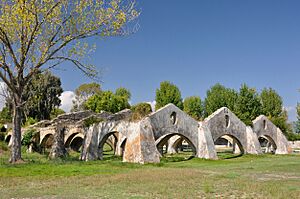
Venice also built a network of other arsenals and naval stations in Greece. These were mainly for repairing ships. They had shipyards in places like the Aegean Sea, Epirus, the Peloponnese, and the Kingdom of Candia (which is modern Crete). Some of these locations included Corfu, Methoni, Koroni, Chalkis, Preveza, Chania, and Heraklion.
See also
- Venetian arsenal, Gouvia
- List of buildings and structures in Venice


